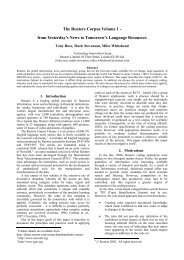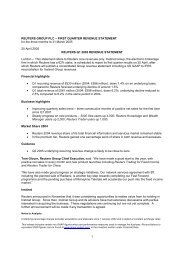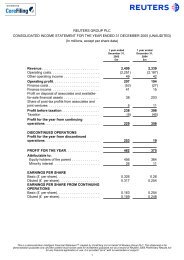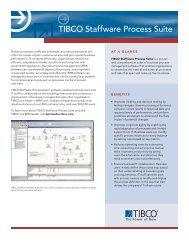TIBCO Staffware Process Suite
TIBCO Staffware Process Suite
TIBCO Staffware Process Suite
You also want an ePaper? Increase the reach of your titles
YUMPU automatically turns print PDFs into web optimized ePapers that Google loves.
Leveraging a Service-Oriented Architecture<br />
An effective BPM<br />
solution will leverage<br />
the concept and<br />
implementation of<br />
SOA, and ultimately the<br />
underlying applications.<br />
Every enterprise has its islands of corporate assets – whether that is the employees,<br />
suppliers, partners (and information about them) or existing IT infrastructure – which<br />
must be connected and then leveraged to achieve corporate objectives. One of the most<br />
efficient and effective methods to integrate applications is through a service-oriented<br />
architecture (SOA). An SOA is an approach to distributed computing that involves<br />
the creation and management of discrete services (e.g. check customer credit, create<br />
customer record) that can access the corporate assets and pieces of information with a<br />
common interface regardless of the location or technical makeup of the function or piece<br />
of data. These services are exposed and managed in a loosely coupled manner that<br />
is designed to maximize reuse, with a natural extension to using these services within<br />
business processes.<br />
The key to delivering improved business processes lies in harmonizing new processes<br />
and applications with existing infrastructures including existing technologies such as<br />
enterprise resource planning (ERP) and customer relationship management (CRM).<br />
An effective BPM solution will leverage the concept and implementation of SOA, and<br />
ultimately the underlying applications. Any solution must bring benefits to the bottom line<br />
without discarding what works. In fact, you can argue that any mature SOA will have to<br />
have a BPM layer in order to organize the execution of the various services available into<br />
a sensible process that meets some business goal. It’s not just that BPM can exploit an<br />
underlying SOA.<br />
Providing technology that enables users to map out the business process in clear<br />
graphical notation is important, but being able to execute that process; facilitating<br />
integration with legacy systems and commercially available packages; and then analyzing<br />
and managing how those processes are working together, is also vital. <strong>TIBCO</strong>’s unique<br />
independent process layer separates the business process logic from the application<br />
layer, making integration much smoother and infinitely scalable. <strong>TIBCO</strong> BusinessWorks is<br />
a leading integration platform that enables organizations to construct and manage their<br />
integration infrastructure. When <strong>TIBCO</strong> BusinessWorks and <strong>TIBCO</strong> <strong>Staffware</strong> <strong>Process</strong><br />
<strong>Suite</strong> are deployed together, organizations are able to maximize control of their business<br />
processes while seamlessly integrating those processes with the underlying applications<br />
and services within an SOA infrastructure.<br />
The combined approach of <strong>TIBCO</strong> <strong>Staffware</strong> <strong>Process</strong> <strong>Suite</strong> and <strong>TIBCO</strong> BusinessWorks<br />
under an SOA infrastructure reduces maintenance costs and time-to-deploy, and makes<br />
the IT function far more responsive to business needs. In the past, there has been much<br />
criticism of the time it takes for IT implementations to deliver any real benefits. Driven<br />
T I B C O S ta f f w a r e P r o c e s s S u i t e














